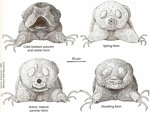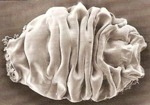







Water bears have been assigned to a separate phylum, Tardigrada, which may be closely related to artropods. With a length of only 0.05 to 1.25 mm they among the smallest of multicellular animals. Almost most of them move in a sluggish, bear-
Although they lack a circulatory system and respiratory organs, the anatomy of a water bear is extremely complex. The body is covered by a chitinous layer that is regularly moulted, as in insects. Females and males occur in most species of water bears. The males actively seeks out the females, many species have complicated courtship behaviour and mating rituals.
Water bears that lives among mosses and lichens are often strongly pigmented from orange and bright red to olive green. Most water bears lives by sucking out the cell contents of bacteria, algae, or mosses. A few species are carnivores, feeding on rotiferans, roundworms, or other water bears. Three marine species are known to parasitize sea cucumbers, barnacles, and bryozoans, respectively.
Water bears are dispersed throughout the globe, from the deep see to the highest peaks of the Himalayas. Unlike in other groups of organisms, the number of species does not decrease from temperature to polar regions. As a matter of fact, over half of the 600 species known toaday have been described from the Arctic or the Antarctique. Thus 115 species are presently known from Greenland but only 33 from Denmark. It further appears that the density of water bears in certain arctic biotopes (temporay bonds, lichen and moss communities) far exceeds what may be found in, e.g. Scandinavia.
The more extreme the environment, the better water bear are able to compeete with other microscopical animals. Their incredible capacity to survive is linked to the fact that many of them are able to withstand dessication during any stage of their cycle life. For example, water bear eggs are regularly found in the air samples that are tested in order to provide information on pollen content to people with allergies.
Laboratory studies have demonstrated that water bears in a state of dessication, cryptobiosis, are capable of withstanding such drastic conditions as radioactive radiations, vacuum, and organic solvents such as 96% alcohol or ether. Water bears in this state may also be heated to 100°C or placed inliquid helium at a temperature of -
This state may last for years. Dried-



